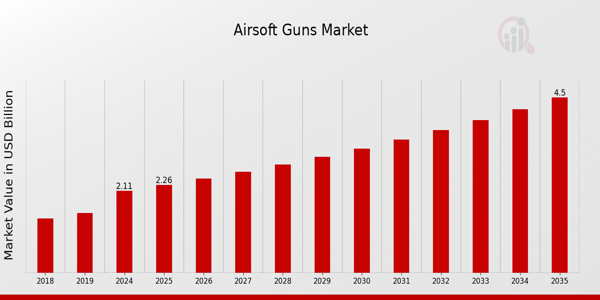Airsoft Guns Industry
Airsoft guns are replica firearms that shoot non-lethal plastic pellets, typically 6mm in diameter. Designed for recreational use, airsoft guns are widely used in military simulation games, competitive team shooting sports, and tactical training by law enforcement and defense personnel. Their growing popularity has led to a booming global market, projected to reach USD 4.5 billion by 2035.
Overview and Functionality
Airsoft gun’s function using three primary mechanisms: spring-powered, gas-powered (CO2 or green gas), and electric-powered (commonly referred to as AEGs – Automatic Electric Guns). Spring-powered models are manually cocked before each shot, while gas and electric variants offer semi-automatic or fully automatic firing capabilities. Although airsoft pellets are low-velocity and non-lethal, users must wear protective gear to prevent injuries during gameplay.
Unlike paintball, airsoft emphasizes realism. The guns often replicate real firearms in design, size, and weight, making them a popular choice for enthusiasts and professionals alike. Many airsoft guns are designed to simulate actual weapons used by the military and police, offering realistic handling for training without the risks of live ammunition.
Applications
Airsoft guns are used across multiple domains:
Recreational Sports: Airsoft games simulate combat scenarios, similar to military operations, with objectives such as capture the flag or team elimination. Players often participate in organized matches and tournaments.
Tactical Training: Law enforcement agencies and military units use airsoft guns for close-quarters battle (CQB) training and tactical drills. The low cost, safety, and realistic functionality make airsoft an ideal tool for training.
Film and Media: Airsoft guns are frequently used in film production as props due to their realistic appearance, offering a safer and more affordable alternative to real firearms.
Market Growth Drivers
Several factors are fueling the growth of the airsoft guns market:
Increased Demand for Recreational Shooting Sports: The rising popularity of adventure sports and combat simulation games has expanded the consumer base, especially among younger audiences.
Growing Interest in Military Simulation (MilSim): Enthusiasts seek realistic combat experiences, prompting manufacturers to produce high-quality, realistic airsoft guns.
Use in Professional Training: Police and military forces in various countries are increasingly adopting airsoft guns for cost-effective training purposes.
Technological Advancements: Innovations such as smart targeting, improved battery life, and durable materials are enhancing the user experience.
Challenges and Regulations
Despite growth, the airsoft industry faces challenges. Regulatory restrictions vary by country, with some regions classifying airsoft guns as firearms due to their realistic appearance. Safety concerns and misuse also necessitate clear regulations and responsible handling. Manufacturers and communities are promoting safety standards and advocating for responsible gameplay to address these concerns.
Conclusion
Airsoft guns have evolved from niche recreational equipment to widely used training and entertainment tools. As innovation continues and demand grows across commercial, recreational, and professional sectors, the airsoft gun market is set to see sustained expansion through 2035 and beyond.

